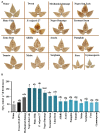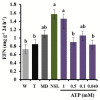Damaged-self recognition in common bean (Phaseolus vulgaris) shows taxonomic specificity and triggers signaling via reactive oxygen species (ROS)
- PMID: 25400650
- PMCID: PMC4215620
- DOI: 10.3389/fpls.2014.00585
Damaged-self recognition in common bean (Phaseolus vulgaris) shows taxonomic specificity and triggers signaling via reactive oxygen species (ROS)
Abstract
Plants require reliable mechanisms to detect injury. Danger signals or "damage-associated molecular patterns" (DAMPs) are released from stressed host cells and allow injury detection independently of enemy-derived molecules. We studied the response of common bean (Phaseolus vulgaris) to the application of leaf homogenate as a source of DAMPs and measured the production of reactive oxygen species (ROS) as an early response and the secretion of extrafloral nectar (EFN) as a jasmonic acid (JA)-dependent late response. We observed a strong taxonomic signal in the response to different leaf homogenates. ROS formation and EFN secretion were highly correlated and responded most strongly to leaf homogenates produced using the same cultivar or closely related accessions, less to a distantly related cultivar of common bean or each of the two congeneric species, P. lunatus and P. coccineus, and not at all to homogenates prepared from species in different genera, not even when using other Fabaceae. Interestingly, leaf homogenates also reduced the infection by the bacterial pathogen, Pseudomonas syringae, when they were applied directly before challenging, although the same homogenates exhibited no direct in vitro inhibitory effect in the bacterium. We conclude that ROS signaling is associated to the induction of EFN secretion and that the specific blend of DAMPs that are released from damaged cells allows the plant to distinguish the "damaged-self" from the damaged "non-self." The very early responses of plants to DAMPs can trigger resistance to both, herbivores and pathogens, which should be adaptive because injury facilitates infection, independently of its causal reason.
Keywords: Pseudomonas syringae; damage-associated molecular pattern; danger signal; extrafloral nectar; induced defense; induced resistance; plant pathogen; wound response.
Figures








Similar articles
-
How plants sense wounds: damaged-self recognition is based on plant-derived elicitors and induces octadecanoid signaling.PLoS One. 2012;7(2):e30537. doi: 10.1371/journal.pone.0030537. Epub 2012 Feb 9. PLoS One. 2012. PMID: 22347382 Free PMC article.
-
Regulation of extrafloral nectar secretion by jasmonates in lima bean is light dependent.Proc Natl Acad Sci U S A. 2010 Oct 5;107(40):17228-33. doi: 10.1073/pnas.1009007107. Epub 2010 Sep 20. Proc Natl Acad Sci U S A. 2010. PMID: 20855624 Free PMC article.
-
Extracellular self-DNA as a damage-associated molecular pattern (DAMP) that triggers self-specific immunity induction in plants.Brain Behav Immun. 2018 Aug;72:78-88. doi: 10.1016/j.bbi.2017.10.010. Epub 2017 Oct 16. Brain Behav Immun. 2018. PMID: 29042243
-
Danger signals - damaged-self recognition across the tree of life.Front Plant Sci. 2014 Oct 31;5:578. doi: 10.3389/fpls.2014.00578. eCollection 2014. Front Plant Sci. 2014. PMID: 25400647 Free PMC article. Review.
-
Adaptations to biotic and abiotic stress: Macaranga-ant plants optimize investment in biotic defence.J Exp Bot. 2001 Oct;52(363):2057-65. doi: 10.1093/jexbot/52.363.2057. J Exp Bot. 2001. PMID: 11559742 Review.
Cited by
-
Damage-Associated Molecular Pattern-Triggered Immunity in Plants.Front Plant Sci. 2019 May 22;10:646. doi: 10.3389/fpls.2019.00646. eCollection 2019. Front Plant Sci. 2019. PMID: 31191574 Free PMC article. Review.
-
Molecular tug-of-war: Plant immune recognition of herbivory.Plant Cell. 2022 Apr 26;34(5):1497-1513. doi: 10.1093/plcell/koac009. Plant Cell. 2022. PMID: 35026025 Free PMC article. Review.
-
Oligosaccharides: Defense Inducers, Their Recognition in Plants, Commercial Uses and Perspectives.Molecules. 2020 Dec 16;25(24):5972. doi: 10.3390/molecules25245972. Molecules. 2020. PMID: 33339414 Free PMC article. Review.
-
Green pesticide: Tapping to the promising roles of plant secreted small RNAs and responses towards extracellular DNA.Noncoding RNA Res. 2021 Feb 13;6(1):42-50. doi: 10.1016/j.ncrna.2021.02.001. eCollection 2021 Mar. Noncoding RNA Res. 2021. PMID: 33778217 Free PMC article. Review.
-
Caterpillar-Induced Volatile Emissions in Cotton: The Relative Importance of Damage and Insect-Derived Factors.Front Plant Sci. 2021 Aug 3;12:709858. doi: 10.3389/fpls.2021.709858. eCollection 2021. Front Plant Sci. 2021. PMID: 34413869 Free PMC article.
References
-
- Akila R., Rajendran L., Harish S., Saveetha K., Raguchander T., Samiyappan R. (2011). Combined application of botanical formulations and biocontrol agents for the management of Fusarium oxysporum f. sp. cubense (Foc) causing Fusarium wilt in banana. Biol. Control 57 175–183. 10.1016/j.biocontrol.2011.02.010 - DOI
-
- Beneloujaephajri E., Costa A., L’Haridon F., Metraux J. P., Binda M. (2013). Production of reactive oxygen species and wound-induced resistance in Arabidopsis thaliana against Botrytis cinerea are preceded and depend on a burst of calcium. BMC Plant Biol. 13:160. 10.1186/1471-2229-13-160 - DOI - PMC - PubMed
-
- Byun-McKay A., Godard K. A., Toudefallah M., Martin D. M., Alfaro R., King J., et al. (2006). Wound-induced terpene synthase gene expression in sitka spruce that exhibit resistance or susceptibility to attack by the white pine weevil. Plant Physiol. 140 1009–1021. 10.1104/pp.105.071803 - DOI - PMC - PubMed
LinkOut - more resources
Full Text Sources
Other Literature Sources

